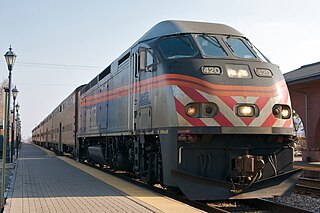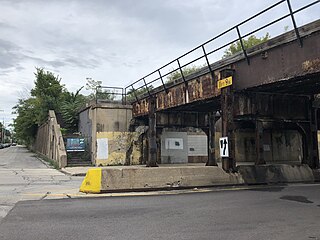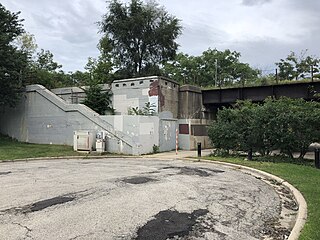Related Research Articles

Metra is the primary commuter rail system in the Chicago metropolitan area serving the city of Chicago and its surrounding suburbs via the Union Pacific Railroad, BNSF Railway, and other railroads. The system operates 243 stations on 11 rail lines. It is the fourth busiest commuter rail system in the United States by ridership and the largest and busiest commuter rail system outside the New York City metropolitan area. In 2023, the system had a ridership of 31,894,900, or about 168,600 per weekday as of the third quarter of 2024. The estimated busiest day for Metra ridership occurred on November 4, 2016—the day of the Chicago Cubs 2016 World Series victory rally, with a record 460,000+ passengers.

The Union Pacific North Line (UP-N) is a Metra line in the Chicago metropolitan area. It runs between Ogilvie Transportation Center and Kenosha, Wisconsin; however, most trains terminate in Waukegan, Illinois. Although Metra owns the rolling stock, the trains are operated and dispatched by the Union Pacific Railroad. This line was previously operated by the Chicago & North Western Railway before its merger with the Union Pacific Railroad, and was called the Chicago and North Western Milwaukee Division and then the Chicago & North Western/North Line before the C&NW was absorbed by Union Pacific in April 1995. It is the only Metra line that travels outside Illinois.

The BNSF Line is a Metra commuter rail line operated by the BNSF Railway in Chicago and its western suburbs, running from Chicago Union Station to Aurora, Illinois through the Chicago Subdivision. In 2010, the BNSF Line continued to have the highest weekday ridership of the 11 Metra lines. While Metra does not refer to its lines by particular colors, the BNSF line's color on Metra timetables is "Cascade Green," in honor of the Burlington Northern Railroad.

The Milwaukee District North Line (MD-N) is a Metra commuter rail line in Chicago, Illinois and its northern suburbs, running from Union Station to Fox Lake. Although Metra does not refer to any of its lines by color, the timetable accents for the Milwaukee District North line are pale "Hiawatha Orange" in honor of the Milwaukee Road's Hiawatha passenger trains.

The Milwaukee District West Line (MD-W) is a Metra commuter rail line in Chicago, Illinois, and its western suburbs. Metra does not refer to any of its lines by a particular color, but the timetable accents for the Milwaukee District West line are dark "Arrow Yellow," honoring the Milwaukee Road's Arrow passenger train. Trains are dispatched from the Canadian Pacific Kansas City Railway's American headquarters in Minneapolis.

The SouthWest Service (SWS) is a Metra commuter rail line, running southwest from Union Station in downtown Chicago, Illinois, to Manhattan, Illinois. Metra does not refer to its lines by color, but the timetable accents for the SouthWest Service line are "Banner Blue," for the Wabash Railroad's Banner Blue passenger train. The trackage is owned by Metra north of a junction with the Belt Railway of Chicago at Loomis Boulevard, and is leased from Norfolk Southern Railway south of the junction.

Ravenswood is a railroad station on the North Side of Chicago serving Metra's Union Pacific North Line. It is located at 4800 North Ravenswood Avenue, just south of West Lawrence Avenue. A previous Ravenswood station was located at Wilson Avenue, but was replaced with the station at the current location, opposite the Chicago and North Western Railway's Ravenswood Accounting Office & Carload Tracing Bureau, which were housed in a building at 4801 North Ravenswood Avenue. In Metra's zone-based fare system, Ravenswood is in zone 2. As of 2018, Ravenswood is the third busiest of Metra's 236 non-downtown stations, with an average of 2,630 weekday boardings. Ravenswood station is near the eastern edge of the Chicago neighborhood also known as Ravenswood and the western edge of Uptown.

Rondout is an unincorporated community in Lake County, Illinois, United States that first formed around a railroad junction. The area is located within Libertyville Township. As Rondout is an unincorporated community rather than a municipality, it lacks clearly defined borders, and shares postal codes with Lake Bluff, Lake Forest and Libertyville, Illinois. It has its own elementary school which comes under Rondout School District 72. Illinois Route 176 passes east–west through Rondout, serving as the "main street" of the community, where it is also called "Rockland Road".

Kenosha is a railroad station in Kenosha, Wisconsin, United States, served by Metra's Union Pacific North Line. It is the northern terminus of the line, which runs south to the Ogilvie Transportation Center in Chicago. Kenosha is the only Metra station outside of Illinois, and is 51.6 miles (83.0 km) from Ogilvie Transportation Center. Because it is located outside the RTA's jurisdiction, the service to the station is partially subsidized by the city of Kenosha. It is the northernmost station of the entire Metra system, making it the most northern station in the entire RTA network. As of 2018, Kenosha is the 135th busiest of Metra's 236 non-downtown stations, with an average of 345 weekday boardings.

West Chicago is a station on Metra's Union Pacific West Line, located in West Chicago, Illinois. The station is 29.7 miles (47.8 km) away from Ogilvie Transportation Center, the eastern terminus of the West Line. In Metra's zone-based fare system, West Chicago is in zone 4. As of 2018, West Chicago is the 88th busiest of the 236 non-downtown stations in the Metra system, with an average of 586 weekday boardings. Unless otherwise announced, inbound trains use the north (side) platform and outbound trains use the south (island) platform.

Prairie Crossing is a pair of Metra stations located in Libertyville, Illinois. They are serviced by the North Central Service and the Milwaukee District North Line. The station is 43.4 miles (69.8 km) away from Chicago Union Station via the North Central Service, and 39.8 miles (64.1 km) via the Milwaukee District North Line. In Metra's zone-based fare system, both Prairie Crossing platforms are in zone 4.

Grayland is a Metra commuter railroad station in the Old Irving Park neighborhood in Chicago, Illinois, along the Milwaukee District North Line. It is located at 3729 North Kilbourn Avenue, is 8.2 miles (13.2 km) away from Chicago Union Station, the southern terminus of the line, and serves commuters between Union Station and Fox Lake, Illinois. In Metra's zone-based fare system, Grayland is in zone 2. As of 2018, Grayland is the 132nd busiest of Metra's 236 non-downtown stations, with an average of 357 weekday boardings.

Dempster Street was a commuter railroad station on the Chicago and North Western Railway's Milwaukee Division, now the Union Pacific North Line. The station was located at Dempster Street and Sherman Avenue, in Evanston, Illinois. It was adjacent the CTA Purple Line's Dempster station.

Calvary was a commuter railroad station on the Chicago and North Western Railway's Milwaukee Division, today's Union Pacific North Line. The station was located at Mulford Street and Chicago Avenue, in Evanston, Illinois.

Rose Hill was a commuter railroad station on the Chicago and North Western Railway's Milwaukee Division, now the Union Pacific North Line. The station was located at Rosehill Drive and Ravenswood Avenue, in Chicago's Edgewater neighborhood. Rose Hill opened in 1855 or 1856, and was in service for more than 100 years before closing in 1958 as part of a service revision on the North Western's commuter lines.

DeKalb station is a former railway station in Downtown DeKalb, Illinois. It served passenger trains of the Chicago and North Western Railway (C&NW) along its main line between Chicago and Omaha. The station was designed by Charles Sumner Frost and Alfred Hoyt Granger in 1891 and closed for passenger service in 1971. The building still stands and is used by the Union Pacific Railroad for offices.

Peterson/Ridge station is a railroad station on the North Side of Chicago serving Metra's Union Pacific North Line. It is located at the intersection of West Peterson Avenue and North Ravenswood Avenue in Chicago's Edgewater community area. A groundbreaking ceremony for construction was held on November 1, 2021. Construction concluded and the station opened on May 20, 2024.

Lake Geneva station was an Amtrak intercity rail station in Zenda, Wisconsin. Commuter service to Zenda was operated by the Milwaukee Road from 1900 to 1982. Lake Geneva station was added as an infill station on the Lake Country Limited on June 15, 2000, to serve the Lake Geneva resort area. The Lake Country Limited was never successful, and service ended on September 23, 2001. Commuter service with a stop near Zenda was studied in 2001, but found to only be marginally feasible.
Ravenswood–Wilson was a commuter railroad station on the Chicago and North Western Railway's Milwaukee Division, now the Union Pacific North Line. The station was located at Wilson and Ravenswood Avenues, in Chicago's Ravenswood neighborhood.
References
- 1 2 "Chicago & North Western Railroad: History of Milwaukee line". Edgewater Historical Society. Retrieved August 10, 2018.
- ↑ "It is One United City". Chicago Tribune . July 16, 1889. p. 1. Retrieved September 6, 2018– via Newspapers.com.
- ↑ "Annexation Completed". Inter Ocean . July 16, 1889. p. 1. Retrieved September 6, 2018– via Newspapers.com.
- ↑ Vandervoort, Bill. "Chicago Track Elevation". Chicago Transit and Railfan. Retrieved August 24, 2018.
- ↑ Wolfe, Sheila (June 15, 1958). "Riders Flay Plan to Shut Rail Depots". Chicago Tribune . p. 10, Part 3. Retrieved September 8, 2018.
- ↑ Wolfe, Sheila (June 15, 1958). "Riders Flay Plan to Shut Rail Depots". Chicago Tribune . p. 1, Part 3. Retrieved September 6, 2018– via Newspapers.com.

- ↑ Unger, Rudolph (November 14, 1958). "Boost Affects 40,000 Daily". Chicago Tribune . p. 1. Retrieved September 6, 2018– via Newspapers.com.

- ↑ Unger, Rudolph (November 14, 1958). "Boost Affects 40,000 Daily". Chicago Tribune . p. 8. Retrieved September 6, 2018– via Newspapers.com.

- ↑ "Commuters in Chicago Must Pay More Now". De Kalb Daily Chronicle. DeKalb, Illinois. December 1, 1958. p. 1. Retrieved September 6, 2018– via Newspapers.com.

- ↑ D'Onofrio, Jessica (20 May 2024). "New Peterson/Ridge Metra station Metra station opens in Edgewater". ABC7 Chicago. Retrieved 1 July 2024.